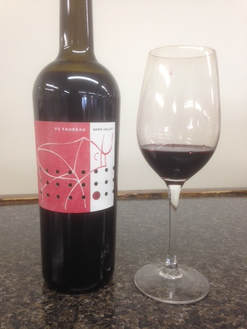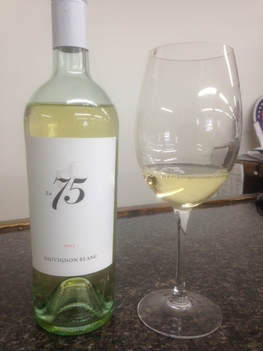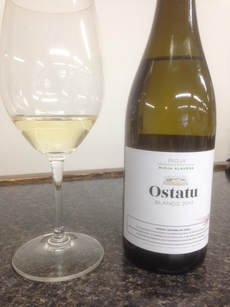 Customers browsing the Californian section of the store will notice a liberal splashing of Jax Vineyards labels that recently arrived. It's unusual for us to get multiple wines into our store in such a broad spread of price points and varieties, but the quality we found in our first tastings forced us to bring in their Chardonnay, Rose, Russian River Pinot Noir, Nap Cabernet Sauvignon, this Napa Red Blend, and a soon to arrive Napa Sauvignon Blanc. Though relatively unknown, this family owned producer works some outstanding sites across Northern California, including their home property in Calistoga where most of this wine is sourced. The 'Y3' label is their value oriented lineup, named in reference to the family cattle ranch, and the Taureau Red pays homage to the farm's prized bull. Primarily Merlot and Cabernet Sauvignon with splashes of Syrah and Zinfandel, the modern styled red is full of black fruits, currants, and dark spices with a slight touch of vanilla from the oak, but not oppressive or intrusive. On the palate the fruit walks the fine line between the tannin of more classic Bordeaux blends and the jammier up-front sweetness that often plagues lesser versions of wines like this. Impressively rich for the price point, this is an ideal wine for a Californian fan that wants to 'drink big', but not 'spend big'.
0 Comments
 The Beckstoffer family is wine royalty in modern California wine history. As Mondavi or countless other winery owners get most of the glory, the importance of the farming side is often overlooked, with the Beckstoffers one of the few superstars. In the mid-1960 Tuck's father Andy moved his family from Richmond, VA to Napa as part of the Heublein Company, which had purchased several prized vineyard sites in Napa. Over the decades the vineyard management company grew to own and farm over 2,500 acres in Napa, Mendocino and Red Hills, providing fruit for some of the most acclaimed wines in the 80's and 90's. While many of you may not recognize the Beckstoffer name at first, if you browse the client lists from their vineyards, you will undoubtedly know the wines that use their fruit. Tuck has followed in the family business, but also moved into the winemaking side about 20 years ago, taking his extensive vineyard knowledge into growing and acquiring grapes for his own projects. The 75 Wine Co. label is more of an entry level label (named after the year he returned to Napa to begin working in the wine industry full time), using mostly sourced fruit from various appellations yet still show great distinction. A pale green/gold color in the glass, the aromas are much more in the zesty citrus and stone fruit world than juicy or tropical, with lots of lime, citrus flowers, and fruit skin tones like pear and peach. The aromas definitely give a sense of the wine being from 'cool climate' sources like Mendocino and Red Hills/Lake County, which provides fruit with crisper fruit aromas and more natural acidity, and the palate definitely shows that off as well with an almost Loire-like racy texture and cool minty vibrancy. There is a touch of the New Zealand style gooseberry fruit on the finish, just enough to give a tanginess to the palate but does not dominate the flavors at all. This is a refreshing crowd-pleaser that works well with lighter cheese and seafood dishes, perfect for early Spring drinking!  Bordeaux and Rioja share a lot of common history and DNA in their wines. During the phylloxera epidemic in the late 1800s, many in the wine industry from Bordeaux migrated to Rioja as the louse had not yet reached the region. The input and knowledge from them helped to shape the quality and improve the standards of the region, providing a large platform for the reputation the region has today. The structure and age-worthiness of the red wines from both regions are strikingly similar, and surprisingly (or maybe not so surprisingly) so are the white. Depending on the blend of grapes used and the use or absence of oak use, the wines can be either fresh and bright or intensive and long lived. This one falls into the 'fresh and bright' category, built from a blend of Viura and Malvasia aged on their lees in stainless steel, but also using native yeasts for fermentation to bring out a unique complexity. Clean and almost clear in color, the nose is mostly stone fruits and melons, a classic aspect of the Viura, along with a prettiness of flowers and black tea from the Malvasia. The native yeasts keep the aromas from getting TOO fruity or tropical, bringing out some subtle savory notes that make the aromas increasingly exotic as it opens up. The palate has a lot of Viura's round waxy mouthfeel, intensified by aging on the lees which brings out a light tannin texture on the finish. This is a great first course food option, lots of rich seafood and poultry possibilities as well. |
The Best of the Best.We offering free tastings on these wines in the store every Thursday and Friday, and a 10% discount off the retail price through the duration of the day. Come on by and give them a try! Archives
July 2024
Categories |
Location |
|

 RSS Feed
RSS Feed